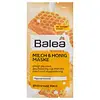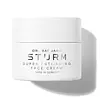What's inside
What's inside
 Key Ingredients
Key Ingredients

 Benefits
Benefits

 Concerns
Concerns

 Ingredients Side-by-side
Ingredients Side-by-side

Water
Skin ConditioningSesamum Indicum Seed Oil
EmollientZea Mays Germ Oil
EmollientGlycerin
HumectantCetearyl Alcohol
EmollientMacadamia Integrifolia Seed Oil
Skin ConditioningDecyl Oleate
EmollientEthylhexyl Isononanoate
EmollientGlyceryl Stearate Citrate
EmollientHydrogenated Vegetable Glycerides
EmollientLac Powder
Skin ConditioningMel
EmollientPersea Gratissima Oil
Skin ConditioningTocopheryl Acetate
AntioxidantPanthenol
Skin ConditioningPhenoxyethanol
PreservativeXanthan Gum
EmulsifyingParfum
MaskingCarbomer
Emulsion StabilisingAllantoin
Skin ConditioningEthylhexylglycerin
Skin ConditioningDisodium EDTA
Sodium Hydroxide
BufferingPrunus Amygdalus Dulcis Oil
Skin ConditioningArachis Hypogaea Oil
Skin ConditioningGlycolipids
Skin ConditioningSclerotium Gum
Emulsion StabilisingDaucus Carota Sativa Root Extract
Skin ConditioningPantolactone
HumectantBenzyl Alcohol
PerfumingIsopropyl Myristate
EmollientSodium Benzoate
MaskingPotassium Sorbate
PreservativeLecithin
EmollientAscorbyl Palmitate
AntioxidantGlyceryl Stearate
EmollientCitric Acid
BufferingPrunus Amygdalus Dulcis Fruit Extract
Skin ConditioningTocopherol
AntioxidantGlyceryl Oleate
EmollientGalactaric Acid
Beta-Carotene
Skin ConditioningWater, Sesamum Indicum Seed Oil, Zea Mays Germ Oil, Glycerin, Cetearyl Alcohol, Macadamia Integrifolia Seed Oil, Decyl Oleate, Ethylhexyl Isononanoate, Glyceryl Stearate Citrate, Hydrogenated Vegetable Glycerides, Lac Powder, Mel, Persea Gratissima Oil, Tocopheryl Acetate, Panthenol, Phenoxyethanol, Xanthan Gum, Parfum, Carbomer, Allantoin, Ethylhexylglycerin, Disodium EDTA, Sodium Hydroxide, Prunus Amygdalus Dulcis Oil, Arachis Hypogaea Oil, Glycolipids, Sclerotium Gum, Daucus Carota Sativa Root Extract, Pantolactone, Benzyl Alcohol, Isopropyl Myristate, Sodium Benzoate, Potassium Sorbate, Lecithin, Ascorbyl Palmitate, Glyceryl Stearate, Citric Acid, Prunus Amygdalus Dulcis Fruit Extract, Tocopherol, Glyceryl Oleate, Galactaric Acid, Beta-Carotene
Water
Skin ConditioningOctyldodecanol
EmollientUrea
BufferingGlycerin
HumectantButyrospermum Parkii Butter
Skin ConditioningDecyl Oleate
EmollientZea Mays Germ Oil
EmollientC12-15 Alkyl Benzoate
AntimicrobialCetearyl Alcohol
EmollientGlyceryl Stearate
EmollientVitis Vinifera Seed Oil
EmollientLactobacillus/Portulaca Oleracea Ferment Extract
AntioxidantPersea Gratissima Oil
Skin ConditioningSorbitol
HumectantPropanediol
SolventPotassium Cetyl Phosphate
EmulsifyingTocopheryl Acetate
AntioxidantDimethicone
EmollientPhenoxyethanol
PreservativeHydrogenated Palm Glycerides
EmollientPanthenol
Skin ConditioningPhytosterols
Skin ConditioningOlea Europaea Fruit Oil
MaskingCarbomer
Emulsion StabilisingXanthan Gum
EmulsifyingEthylhexylglycerin
Skin ConditioningPotassium Sorbate
PreservativeLeuconostoc/Radish Root Ferment Filtrate
AntimicrobialAlcohol
AntimicrobialSorbitan Oleate
EmulsifyingCaprylic/Capric Triglyceride
MaskingBaicalin
AntioxidantAscorbyl Palmitate
AntioxidantPantolactone
HumectantCitric Acid
BufferingAscorbic Acid
AntioxidantWater, Octyldodecanol, Urea, Glycerin, Butyrospermum Parkii Butter, Decyl Oleate, Zea Mays Germ Oil, C12-15 Alkyl Benzoate, Cetearyl Alcohol, Glyceryl Stearate, Vitis Vinifera Seed Oil, Lactobacillus/Portulaca Oleracea Ferment Extract, Persea Gratissima Oil, Sorbitol, Propanediol, Potassium Cetyl Phosphate, Tocopheryl Acetate, Dimethicone, Phenoxyethanol, Hydrogenated Palm Glycerides, Panthenol, Phytosterols, Olea Europaea Fruit Oil, Carbomer, Xanthan Gum, Ethylhexylglycerin, Potassium Sorbate, Leuconostoc/Radish Root Ferment Filtrate, Alcohol, Sorbitan Oleate, Caprylic/Capric Triglyceride, Baicalin, Ascorbyl Palmitate, Pantolactone, Citric Acid, Ascorbic Acid
 Reviews
Reviews

Ingredients Explained
These ingredients are found in both products.
Ingredients higher up in an ingredient list are typically present in a larger amount.
Ascorbyl Palmitate is created by combining pure Vitamin C and palmitic acid. It is an antioxidant and helps reduce hyperpigmentation.
This ingredient is a more stable version of Vitamin C, meaning it does not disintegrate as quickly when exposed to sunlight. However, studies show it does not penetrate skin as well as pure Vitamin C.
Ascorbyl Palmitate is oil soluble.
Read more about other types of Vitamin C:
Learn more about Ascorbyl PalmitateCarbomer is a polymer of acrylic acid. Its main role is to create a gel consistency.
A high amount of carbomer can cause pilling or balling up of products. Don't worry, most products contain 1% or less of carbomer.
Cetearyl alcohol is a mixture of two fatty alcohols: cetyl alcohol and stearyl alcohol. It is mainly used as an emulsifier. Emulsifiers help prevent the separation of oils and products. Due to its composition, it can also be used to thicken a product or help create foam.
Cetearyl alcohol is an emollient. Emollients help soothe and hydrate the skin by trapping moisture.
Studies show Cetearyl alcohol is non-toxic and non-irritating. The FDA allows products labeled "alcohol-free" to have fatty alcohols.
This ingredient is usually derived from plant oils such as palm, vegetable, or coconut oils. There is debate on whether this ingredient will cause acne.
Due to the fatty acid base, this ingredient may not be Malassezia folliculitis safe.
Learn more about Cetearyl AlcoholCitric Acid is an alpha hydroxy acid (AHA) naturally found in citrus fruits like oranges, lemons, and limes.
Like other AHAs, citric acid can exfoliate skin by breaking down the bonds that hold dead skin cells together. This helps reveal smoother and brighter skin underneath.
However, this exfoliating effect only happens at high concentrations (20%) which can be hard to find in cosmetic products.
Due to this, citric acid is usually included in small amounts as a pH adjuster. This helps keep products slightly more acidic and compatible with skin's natural pH.
In skincare formulas, citric acid can:
While it can provide some skin benefits, research shows lactic acid and glycolic acid are generally more effective and less irritating exfoliants.
Most citric acid used in skincare today is made by fermenting sugars (usually from molasses). This synthetic version is identical to the natural citrus form but easier to stabilize and use in formulations.
Read more about some other popular AHA's here:
Learn more about Citric AcidDecyl Oleate comes from decyl alcohol and oleic acid.
Decyl Oleate is an emollient. It helps moisturize the skin by creating a thin barrier on top to prevent moisture from escaping.
This ingredient may not be fungal-acne safe.
Learn more about Decyl OleateEthylhexylglycerin (we can't pronounce this either) is commonly used as a preservative and skin softener. It is derived from glyceryl.
You might see Ethylhexylglycerin often paired with other preservatives such as phenoxyethanol. Ethylhexylglycerin has been found to increase the effectiveness of these other preservatives.
Glycerin is already naturally found in your skin. It helps moisturize and protect your skin.
A study from 2016 found glycerin to be more effective as a humectant than AHAs and hyaluronic acid.
As a humectant, it helps the skin stay hydrated by pulling moisture to your skin. The low molecular weight of glycerin allows it to pull moisture into the deeper layers of your skin.
Hydrated skin improves your skin barrier; Your skin barrier helps protect against irritants and bacteria.
Glycerin has also been found to have antimicrobial and antiviral properties. Due to these properties, glycerin is often used in wound and burn treatments.
In cosmetics, glycerin is usually derived from plants such as soybean or palm. However, it can also be sourced from animals, such as tallow or animal fat.
This ingredient is organic, colorless, odorless, and non-toxic.
Glycerin is the name for this ingredient in American English. British English uses Glycerol/Glycerine.
Learn more about GlycerinGlyceryl Stearate is a mix of glycerin and stearic acid.
It is used to stabilize the mixing of water and oil ingredients. By preventing these ingredients from separating, it can help elongate shelf life. It can also help thicken the product's texture.
As an emollient, it helps soften skin and supports barrier-replenishing ingredients.
In cosmetics, Glyceryl Stearate is often made from vegetable oils or synthetically produced.
This ingredient may not be fungal-acne safe
Fun fact: The human body also creates Glyceryl Stearate naturally.
Learn more about Glyceryl StearatePanthenol is a common ingredient that helps hydrate and soothe the skin. It is found naturally in our skin and hair.
There are two forms of panthenol: D and L.
D-panthenol is also known as dexpanthenol. Most cosmetics use dexpanthenol or a mixture of D and L-panthenol.
Panthenol is famous due to its ability to go deeper into the skin's layers. Using this ingredient has numerous pros (and no cons):
Like hyaluronic acid, panthenol is a humectant. Humectants are able to bind and hold large amounts of water to keep skin hydrated.
This ingredient works well for wound healing. It works by increasing tissue in the wound and helps close open wounds.
Once oxidized, panthenol converts to pantothenic acid. Panthothenic acid is found in all living cells.
This ingredient is also referred to as pro-vitamin B5.
Learn more about PanthenolPantolactone is a synthetically created humectant.
As a humectant, Pantolactone helps draw moisture to the skin. It can help add hydration to your skin.
Persea Gratissima Oil is also known as avocado oil.
Avocado Oil has antioxidant properties. It is mostly made up of the glycerides of fatty acids. About 67% of these fatty acids is made up of oleic acid. Palmitic acid and linoleic acid are also present.
These fatty acids help hydrate and soften the skin. It may increase collagen content in the skin. Collagen helps keep your skin plump and firm. This ingredient helps reduce inflammation and has not shown to clog pores.
This ingredient may not be fungal-acne safe due to its high fatty acid content.
Avocados also have B vitamins, vitamin K, vitamin C, vitamin E, and potassium.
Learn more about Persea Gratissima OilPhenoxyethanol is a preservative that has germicide, antimicrobial, and aromatic properties. Studies show that phenoxyethanol can prevent microbial growth. By itself, it has a scent that is similar to that of a rose.
It's often used in formulations along with Caprylyl Glycol to preserve the shelf life of products.
Potassium Sorbate is a preservative used to prevent yeast and mold in products. It is commonly found in both cosmetic and food products.
This ingredient comes from potassium salt derived from sorbic acid. Sorbic acid is a natural antibiotic and effective against fungus.
Both potassium sorbate and sorbic acid can be found in baked goods, cheeses, dried meats, dried fruit, ice cream, pickles, wine, yogurt, and more.
You'll often find this ingredient used with other preservatives.
Learn more about Potassium SorbateTocopheryl Acetate is AKA Vitamin E. It is an antioxidant and protects your skin from free radicals. Free radicals damage the skin by breaking down collagen.
One study found using Tocopheryl Acetate with Vitamin C decreased the number of sunburned cells.
Tocopheryl Acetate is commonly found in both skincare and dietary supplements.
Learn more about Tocopheryl AcetateWater. It's the most common cosmetic ingredient of all. You'll usually see it at the top of ingredient lists, meaning that it makes up the largest part of the product.
So why is it so popular? Water most often acts as a solvent - this means that it helps dissolve other ingredients into the formulation.
You'll also recognize water as that liquid we all need to stay alive. If you see this, drink a glass of water. Stay hydrated!
Learn more about WaterXanthan gum is used as a stabilizer and thickener within cosmetic products. It helps give products a sticky, thick feeling - preventing them from being too runny.
On the technical side of things, xanthan gum is a polysaccharide - a combination consisting of multiple sugar molecules bonded together.
Xanthan gum is a pretty common and great ingredient. It is a natural, non-toxic, non-irritating ingredient that is also commonly used in food products.
Learn more about Xanthan GumZea Mays Germ Oil comes from corn.
It is an occlusive skin conditioning agent.